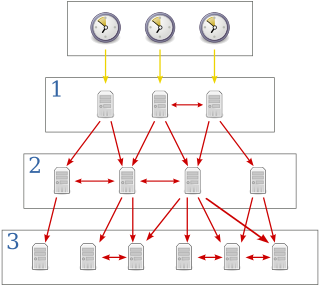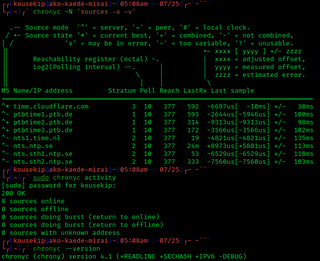Latency, from a general point of view, is a time delay between the cause and the effect of some physical change in the system being observed. Lag, as it is known in gaming circles, refers to the latency between the input to a simulation and the visual or auditory response, often occurring because of network delay in online games.
The Transmission Control Protocol (TCP) is one of the main protocols of the Internet protocol suite. It originated in the initial network implementation in which it complemented the Internet Protocol (IP). Therefore, the entire suite is commonly referred to as TCP/IP. TCP provides reliable, ordered, and error-checked delivery of a stream of octets (bytes) between applications running on hosts communicating via an IP network. Major internet applications such as the World Wide Web, email, remote administration, and file transfer rely on TCP, which is part of the Transport Layer of the TCP/IP suite. SSL/TLS often runs on top of TCP.
In electronics and telecommunications, jitter is the deviation from true periodicity of a presumably periodic signal, often in relation to a reference clock signal. In clock recovery applications it is called timing jitter. Jitter is a significant, and usually undesired, factor in the design of almost all communications links.
Voice over Internet Protocol (VoIP), also called IP telephony, is a method and group of technologies for voice calls, the delivery of voice communication sessions over Internet Protocol (IP) networks, such as the Internet.

The Network Time Protocol (NTP) is a networking protocol for clock synchronization between computer systems over packet-switched, variable-latency data networks. In operation since before 1985, NTP is one of the oldest Internet protocols in current use. NTP was designed by David L. Mills of the University of Delaware.

A network interface controller is a computer hardware component that connects a computer to a computer network.
TCP offload engine (TOE) is a technology used in some network interface cards (NIC) to offload processing of the entire TCP/IP stack to the network controller. It is primarily used with high-speed network interfaces, such as gigabit Ethernet and 10 Gigabit Ethernet, where processing overhead of the network stack becomes significant. TOEs are often used as a way to reduce the overhead associated with Internet Protocol (IP) storage protocols such as iSCSI and Network File System (NFS).
Network performance refers to measures of service quality of a network as seen by the customer.
Professional video over IP systems use some existing standard video codec to reduce the program material to a bitstream, and then to use an Internet Protocol (IP) network to carry that bitstream encapsulated in a stream of IP packets. This is typically accomplished using some variant of the RTP protocol.
AES47 is a standard which describes a method for transporting AES3 professional digital audio streams over Asynchronous Transfer Mode (ATM) networks.
The Precision Time Protocol (PTP) is a protocol used to synchronize clocks throughout a computer network. On a local area network, it achieves clock accuracy in the sub-microsecond range, making it suitable for measurement and control systems. PTP is employed to synchronize financial transactions, mobile phone tower transmissions, sub-sea acoustic arrays, and networks that require precise timing but lack access to satellite navigation signals.
Capacity management's goal is to ensure that information technology resources are sufficient to meet upcoming business requirements cost-effectively. One common interpretation of capacity management is described in the ITIL framework. ITIL version 3 views capacity management as comprising three sub-processes: business capacity management, service capacity management, and component capacity management.
Bandwidth management is the process of measuring and controlling the communications on a network link, to avoid filling the link to capacity or overfilling the link, which would result in network congestion and poor performance of the network. Bandwidth is described by bit rate and measured in units of bits per second (bit/s) or bytes per second (B/s).
In capital markets, low latency is the use of algorithmic trading to react to market events faster than the competition to increase profitability of trades. For example, when executing arbitrage strategies the opportunity to "arb" the market may only present itself for a few milliseconds before parity is achieved. To demonstrate the value that clients put on latency, in 2007 a large global investment bank has stated that every millisecond lost results in $100m per annum in lost opportunity.
HPC Challenge Benchmark combines several benchmarks to test a number of independent attributes of the performance of high-performance computer (HPC) systems. The project has been co-sponsored by the DARPA High Productivity Computing Systems program, the United States Department of Energy and the National Science Foundation.
PTPd is an open source implementation of the Precision Time Protocol for Unix-like computers.
RTP-MIDI is a protocol to transport MIDI messages within Real-time Transport Protocol (RTP) packets over Ethernet and WiFi networks. It is completely open and free, and is compatible both with LAN and WAN application fields. Compared to MIDI 1.0, RTP-MIDI includes new features like session management, device synchronization and detection of lost packets, with automatic regeneration of lost data. RTP-MIDI is compatible with real-time applications, and supports sample-accurate synchronization for each MIDI message.

Bullrun is a clandestine, highly classified program to crack encryption of online communications and data, which is run by the United States National Security Agency (NSA). The British Government Communications Headquarters (GCHQ) has a similar program codenamed Edgehill. According to the Bullrun classification guide published by The Guardian, the program uses multiple methods including computer network exploitation, interdiction, industry relationships, collaboration with other intelligence community entities, and advanced mathematical techniques.
AES67 is a technical standard for audio over IP and audio over Ethernet (AoE) interoperability. The standard was developed by the Audio Engineering Society and first published in September 2013. It is a layer 3 protocol suite based on existing standards and is designed to allow interoperability between various IP-based audio networking systems such as RAVENNA, Livewire, Q-LAN and Dante.

chrony is an implementation of the Network Time Protocol (NTP). It is an alternative to ntpd, a reference implementation of NTP. It runs on Unix-like operating systems and is released under the GNU GPL v2. It is the default NTP client and server in Red Hat Enterprise Linux 8 and SUSE Linux Enterprise Server 15, and available in many Linux distributions.





